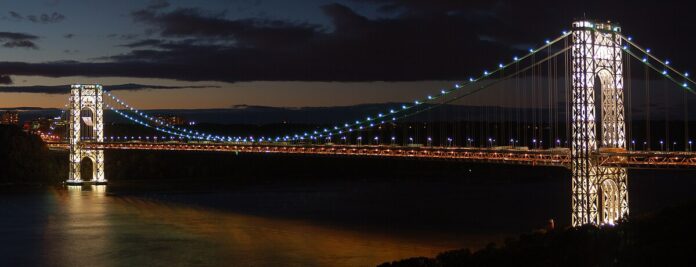“Talking Transportation”
By Jim Cameron
President
CAMERON COMMUNICATIONS INC
Author: “Off The Record: Confessions of a Media Consultant“
With the sad news out of Baltimore this week about the collapse of the Key Bridge, I thought we’d reprise a story I wrote awhile back about NYC’s iconic George Washington bridge.

It’s the bridge we love to hate. Congested, expensive ($17 toll) and nowhere near as modern as the new Tappan Zee Bridge, the George Washington Bridge is best to be avoided, but often you can’t.
The “GW” was not the first New York City bridge designed to cross the Hudson River. Back in 1885 there were discussions about building a suspension bridge to bring the Pennsylvania Railroad into Manhattan at 23rd Street. Tunnels proved a better idea in 1904.
By the 1920’s it was automobile traffic that needed access and designers conceived of a double deck, 16-lane wide roadway (with an additional 12 tracks for railroads on the lower level), crossing at 57th Street.
But it was in 1927 and farther uptown that construction finally began on the George Washington Bridge, crossing from the NJ Palisades to 179th Street in Manhattan. The $75 million single-level bridge opened in 1931 with six lanes of traffic, widened by another two lanes in 1946.
Initially the span was to be called The Bi-State Bridge, The Bridge of Prosperity or The Gate of Paradise, but a naming campaign by school kids ended up honoring our first President.
Fortunately, the bridge’s designers had planned for future growth and in 1962 the lower level, six-lane “Martha Washington” section of the bridge was opened, increasing capacity by 75%.
Unless you see the bridge from the Hudson River, it’s hard to take it all in. Highway approaches from the east and west don’t give you much perspective. And it’s hard to play sightseer when you’re coping with all that traffic.
Original plans called for the bridge to be clad in concrete and granite, but the open criss-cross girders and bracing are much more elegant. Though we take it for granted, the GW is recognized by architects as one of the most beautiful bridges in the word.
In its first year of operations the bridge carried 5.5 million vehicles. In recent years the counts exceed 100 million per year. While vehicles pay tolls, there’s one way to cross the bridge for free: by walking. While offering great views, the bridge’s pedestrian walkways have a dark side… suicide attempts.
Though motorists never see it, the bridge also has its own bus terminal on the New York side, sitting astride the Trans-Manhattan Expressway (not the Cross Bronx) serving 1000 buses and some 20,000 passengers each day. Officially known as The George Washington Bridge Bus Station, the terminal recently underwent a $180 million renovation.
The bridge itself also got a facelift. In 2011 the Port Authority announced an eight-year, $1 billion project to replace 529 vertical suspender wires holding up the roadways.
A great time to cross the bridge is on important civic holidays, including President’s Day, when the world’s largest free-flying American flag is displayed on the New Jersey tower. Measuring 90 feet in length and 60 feet wide, the flag weighs 450 pounds.

Jim Cameron is founder of the Commuter Action Group and advocates for Connecticut rail riders. His weekly column “Talking Transportation” is archived here. You can contact Jim at CommuterActionGroup@gmail.com.”

